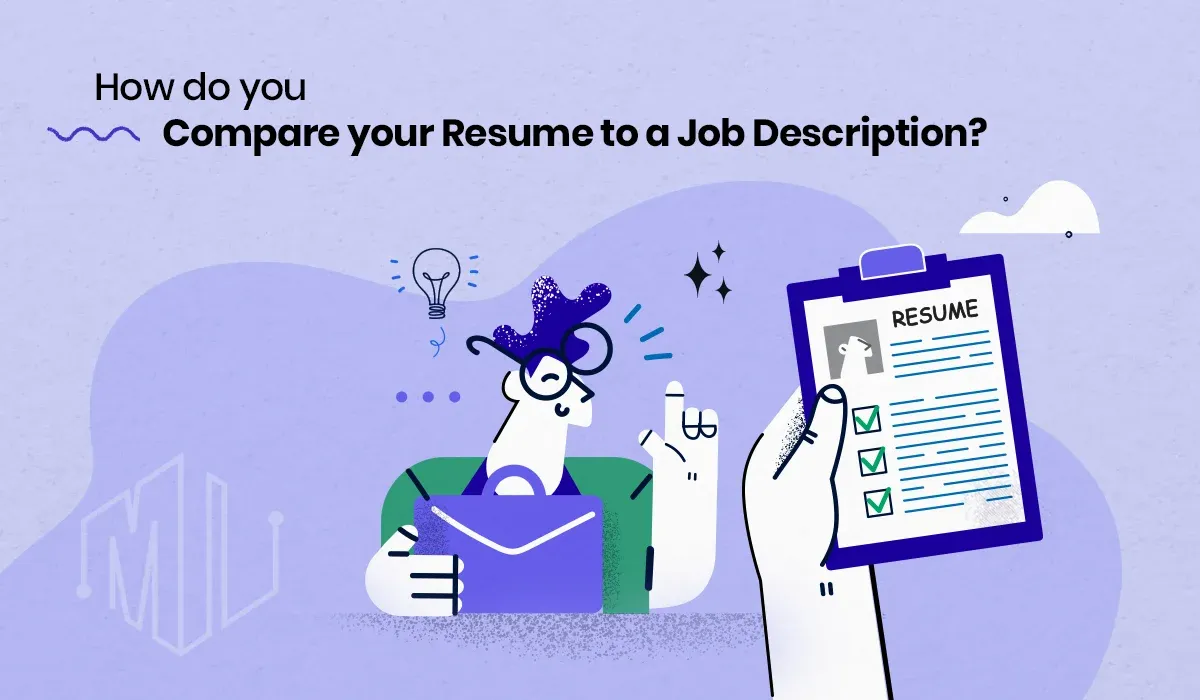How do you Compare your Resume to a Job Description?
In today's competitive job market, aligning your resume with the job description is crucial.

Aligning your resume with the job description not only highlights your suitability for the role but also ensures that your application stands out to hiring managers and applicant tracking systems (ATS).
The process of comparing your resume to a job description involves a strategic analysis of both to identify and emphasize the key skills, experiences, and qualifications that are most relevant to the position.
This blog post aims to guide you through the steps to effectively compare your resume to a job description, ensuring that your application is tailored and targeted, thereby significantly increasing your chances of landing that coveted interview. By mastering this technique, you set the stage for a more successful job search journey.
✨ Unleash the Power of AI with MagicalAPI!
Whether you’re optimizing YouTube content, extracting LinkedIn data, or evaluating resumes, MagicalAPI is your one-stop solution! Discover the diverse range of AI services tailored to meet your every need. Dive in and elevate your digital experience today!

Role of Job Description in Resume Comparison
Understanding the role of a job description is key when you aim to compare your resume to it effectively. Here's how it functions:
- Blueprint for Requirements: The job description serves as a blueprint, outlining the specific skills, qualifications, and experiences the employer is seeking.
- Keyword Source: It's a rich source of keywords and phrases that you should incorporate into your resume to ensure it aligns with what the employer is looking for.
- Guideline for Tailoring: Use the job description as a guide to tailor your resume, highlighting the most relevant aspects of your experience and skills.
- Comparison Benchmark: It acts as a benchmark for comparison, helping you understand gaps in your resume and areas where you exceed requirements.
- Understanding Company Culture: Often, job descriptions provide insights into the company culture and values, which you can reflect in your resume to show a good fit.
By leveraging the job description in these ways, you can create a more targeted and effective resume that resonates with the specific needs of the employer, enhancing your chances of getting noticed.
Analyzing Your Resume
Once you've understood the job description, the next step is to turn the spotlight on your resume. This critical self-assessment helps you identify areas that need improvement and ensures your resume aligns with the job you're pursuing. Here's how to effectively analyze your resume:
1. Compare with the Job Description: Start by comparing your resume side by side with the job description. This visual comparison allows you to spot gaps and mismatches more easily.
2. Highlight Relevant Skills: Identify skills and qualifications on your resume that directly correspond to the requirements in the job description. These should be front and center in your resume.
3. Quantify Achievements: Look for opportunities to quantify your achievements on your resume. Use numbers, percentages, or specific results to demonstrate your impact in previous roles.
4. Prioritize Key Points: Emphasize your most relevant experiences and accomplishments that directly relate to the job description. Remember that the top third of your resume is prime real estate, so place your strongest points there.
5. Remove Irrelevant Information: If you have content on your resume that doesn't contribute to your candidacy for the specific job, consider removing it. Streamlining your resume makes it more focused and impactful.
6. Address Skill Gaps: If there are gaps in your skills or qualifications compared to the job description, consider how you can address them. This might involve gaining relevant certifications, taking courses, or highlighting transferable skills.
7. Customize Your Summary/Objective: If you include a summary or objective statement at the beginning of your resume, tailor it to align with the specific job you're applying for. This sets the tone for the rest of your document.
8. Relevance Over Chronology: In some cases, it may make sense to reorder your resume sections based on relevance rather than chronology. Highlight the most relevant experiences and qualifications first.
9. Address Any Red Flags: If you have employment gaps or other potential red flags, be prepared to address them either in your resume or during the interview process.
10. Seek Feedback: Don't hesitate to ask for feedback from trusted colleagues, mentors, or professional resume writers. Fresh perspectives can help you identify blind spots.
Read more: How to check if my CV is good or bad?
What Resume Are Companies Looking For?
When you analyze your Resume, it's crucial to understand what companies typically look for in a resume. Here are some key points:
- Relevant Keywords: Resumes should include keywords and phrases from the job description, ensuring they pass through Applicant Tracking Systems.
- Quantifiable Achievements: Employers prefer resumes that showcase quantifiable achievements relevant to the role.
- Clear and Concise Format: A well-organized, easy-to-read resume format is highly favored.
- Evidence of Skills and Expertise: Companies look for clear evidence of the skills and expertise claimed in the resume.
- Customization for the Role: A generic resume is less appealing than one tailored for the specific role and company.
- Professionalism: This includes error-free, well-written content that maintains a professional tone.
By understanding these preferences, you can tailor your resume effectively, ensuring it resonates with what companies seek.

Crafting a Resume that Matches the Company's Needs
To create a resume that aligns with a company's needs, follow these steps:
- Analyze the Job Description: Start by thoroughly reading the job description to understand the key requirements.
- Identify Keywords: Pick out important keywords and phrases from the job description; these are likely what the company prioritizes.
- Showcase Relevant Skills: Highlight skills and experiences in your resume that directly align with those mentioned in the job description.
- Quantify Achievements: Use quantifiable achievements to demonstrate how you've effectively used the required skills in the past.
- Customize for Each Application: Tailor your resume for each job application, reflecting the unique requirements of each job description.
- Use a Clear, Professional Format: Ensure your resume is easy to read and professionally formatted.
- Reflect Company Values: If the company's values or culture are mentioned, reflect these in your resume to show you're a good fit.
Note: embrace the potential of new AI tools, such as Resume Score tools, to elevate your resume crafting process. These innovative technologies offer a helping hand in tailoring your resume for the perfect job match. By harnessing the insights and recommendations provided by AI, you can significantly improve your chances of standing out to potential employers.
By meticulously crafting your resume to match the company's needs, you increase the chances of your resume resonating with the employer and advancing your application.
Common Resume Mistakes to Avoid
When aligning your resume with a job description, certain practices should be avoided to ensure your resume makes a positive impact. Here's what not to do:
- Overloading with Irrelevant Information: Avoid including experiences or skills that don't relate to the job description.
- Using Generic Language: Steer clear of clichés and generic phrases that don’t differentiate you from other candidates.
- Ignoring Keywords: Failing to include relevant keywords from the job description can result in your resume being overlooked by ATS systems.
- Being Vague: Avoid ambiguous statements. Be specific in showcasing your achievements and skills.
- One-Size-Fits-All Approach: Don’t use the same resume for every application. Tailor it to match each job description.
- Neglecting Format and Design: A poorly formatted resume can be difficult to read and unappealing to hiring managers.
- Inaccuracies and Exaggerations: Always be truthful about your skills and experiences. Misrepresenting yourself can lead to problems later.
Conclusion
By avoiding these pitfalls, you can create a more effective and appealing resume, increasing your chances of landing the job.
By following these guidelines, you can create a resume that not only compares well with the job description but also stands out to potential employers.
For an added advantage, consider using our Resume Score service. This tool helps you understand how well your resume matches up with specific job descriptions, providing you with actionable feedback to enhance your application. With Resume Score, elevate your resume to meet the demands of today's job market effectively.
FAQ
- How do I compare my resume to a job description?
Place your resume and the job description side by side, highlight key skills and qualifications in the job listing, and ensure these are included in your resume using similar language . - How do I tailor my resume to a job description?
Customize your resume by incorporating specific keywords and phrases from the job description, and quantify your achievements to demonstrate impact. Use tools like Teal or Jobscan to optimize alignment. - Why match my resume to the job description?
Matching your resume to the job description highlights relevant skills, making it easier for hiring managers and ATS to identify you as a strong candidate, increasing your chances of getting an interview.

Join to our community
By joining our Discord server, get assistance, and troubleshoot any challenges you may encounter while using our services.
Join us on Discord




